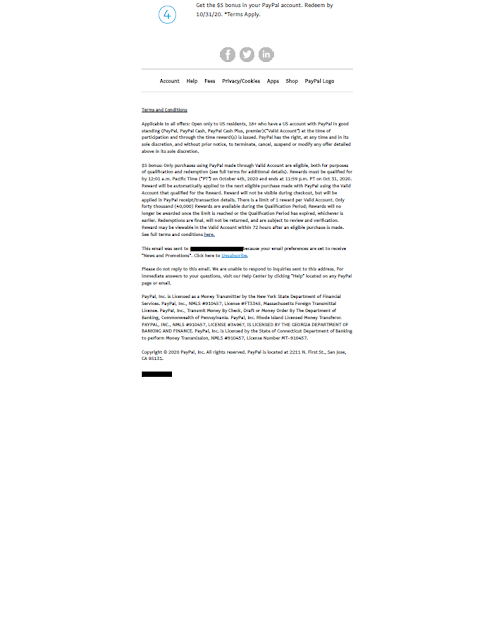This recent email from PayPal trying to cross-sell Venmo merits Fails for Creative and Targeting.

Enrollment offer email, sent to long-term
Venmo customer
The email offers
me a straight cash bribe (or, as we say in marketing, an incentive) to sign up
for Venmo. The Call to Action is to click on the “Claim Your $10” link that
will bring me to the below landing page.

Landing page
lacks explanation of Venmo product features or customer benefits
The landing page
reinforces the incentive and discloses information about fees -- and allows me
to sign up for Venmo and verify my phone number.
But what is
Venmo? Neither the email nor landing page include a product explanation.
Simply put: If someone hasn’t used Venmo -- which is, after all, the kind of
person the email is targeting -- they would have no idea what it is
or why they should provide their mobile number to get $10. Both the email and
landing page should include benefit statements or at least some brief sales
messages.
Now, in fact, I
know all about Venmo. I’ve been using it for a long time, long enough for
Venmo’s parent PayPal to know that I am an active customer. That is why I give this a Fail for Targeting. There is no value in sending a new customer acquisition
offer to a long-term active customer like myself. Communications like this can
make customers question the strength of a brand.
Speaking of
brand, why doesn’t PayPal put its name behind Venmo -- at least on this
marketing email? For customers who haven’t heard of or used Venmo (like the
ones targeted by the offer), including phrasing such as “backed by PayPal” or
“a PayPal service” would at least lend some credibility to the product.
This isn’t the
first time PayPal has offered me an incentive for something without
explanation. Last year, PayPal sent me an offer for Honey that lacked a product value proposition. Nor is this the first time that PayPal has demeaned its
brand with shoddy marketing communications. These communications can implicitly
send a message to customers that PayPal doesn’t have its act together, which
could lead to decreased trust and decreased use. Is this a company to trust with cryptocurrency purchases?
Sometimes
marketing managers are so obsessed with their products, they forget the basics. That’s why they need to take a step back, review lessons like
the below, and avoid sending Mail That Fails.
Lessons:
- Explain what it is you are selling and why it is beneficial.
- Extend your new customer offer only to potential new customers.
- If selling an affiliate service, consider explaining the relationship with the affiliate.


